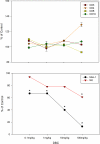Dibenzo[def,p]chrysene (DBC) suppresses antibody formation in spleen cells following oral exposures of mice
- PMID: 23151208
- PMCID: PMC3594787
- DOI: 10.1080/15287394.2012.722521
Dibenzo[def,p]chrysene (DBC) suppresses antibody formation in spleen cells following oral exposures of mice
Abstract
Dibenzo[def,p]chrysene (DBC) is a potent environmental carcinogen in rodents, fish, and human cells examined in culture. There are numerous similarities between the patterns of cytochrome P-450 (P450) activation of DBC and its covalent binding to DNA and proteins with another polycyclic aromatic hydrocarbon (PAH), 7,12-dimethylbenz[a]anthracene (DMBA). Our lab has previously shown that DMBA produces immunosuppression in rodents and human cell systems. Therefore, the purpose of these studies was to examine the immunotoxicity of DBC in a rodent model that was found to be sensitive to the immunosuppressive effects of DMBA. Data showed that DBC had similar potency to DMBA in producing suppression of a T-dependent antibody response (TDAR) and altered spleen cell subsets in a similar manner as DMBA when DMBA was given by gavage for 5 d in corn oil to mice at doses of 1-100 mg/kg total cumulative doses. T-cell-independent antigen (TNP-Ficoll) responses were quantitatively less sensitive to DBC suppression. It was also found that as with DMBA, DBC produced a persistent immunosuppression, which lasted for at least 4 wk following dosing with a novel pill method for self-administration of DBC. In conclusion, DBC appears to possess many of the same characteristics of DMBA in terms of its immunotoxicity.
Figures







Similar articles
-
Analysis of dibenzo[def,p]chrysene-deoxyadenosine adducts in wild-type and cytochrome P450 1b1 knockout mice using stable-isotope dilution UHPLC-MS/MS.Mutat Res Genet Toxicol Environ Mutagen. 2015 Apr;782:51-6. doi: 10.1016/j.mrgentox.2015.03.007. Epub 2015 Mar 12. Mutat Res Genet Toxicol Environ Mutagen. 2015. PMID: 25868132 Free PMC article.
-
Transcriptional Profiling of Dibenzo[def,p]chrysene-induced Spleen Atrophy Provides Mechanistic Insights into its Immunotoxicity in MutaMouse.Toxicol Sci. 2016 Jan;149(1):251-68. doi: 10.1093/toxsci/kfv232. Epub 2015 Oct 24. Toxicol Sci. 2016. PMID: 26496743
-
Low-dose synergistic immunosuppression of T-dependent antibody responses by polycyclic aromatic hydrocarbons and arsenic in C57BL/6J murine spleen cells.Toxicol Appl Pharmacol. 2010 Jun 15;245(3):344-51. doi: 10.1016/j.taap.2010.03.020. Epub 2010 Mar 28. Toxicol Appl Pharmacol. 2010. PMID: 20353797 Free PMC article.
-
Cytochrome P450 1B1 is required for 7,12-dimethylbenz(a)-anthracene (DMBA) induced spleen cell immunotoxicity.Toxicol Sci. 2005 Jul;86(1):68-74. doi: 10.1093/toxsci/kfi176. Epub 2005 Apr 20. Toxicol Sci. 2005. PMID: 15843505
-
Polycyclic aromatic hydrocarbons as skin carcinogens: comparison of benzo[a]pyrene, dibenzo[def,p]chrysene and three environmental mixtures in the FVB/N mouse.Toxicol Appl Pharmacol. 2012 Nov 1;264(3):377-86. doi: 10.1016/j.taap.2012.08.014. Epub 2012 Aug 23. Toxicol Appl Pharmacol. 2012. PMID: 22935520 Free PMC article.
Cited by
-
Editor's Highlight: Interactive Genotoxicity Induced by Environmentally Relevant Concentrations of Benzo(a)Pyrene Metabolites and Arsenite in Mouse Thymus Cells.Toxicol Sci. 2016 Nov;154(1):153-161. doi: 10.1093/toxsci/kfw151. Epub 2016 Aug 7. Toxicol Sci. 2016. PMID: 27503386 Free PMC article.
-
Arsenite Interacts with Dibenzo[def,p]chrysene (DBC) at Low Levels to Suppress Bone Marrow Lymphoid Progenitors in Mice.Biol Trace Elem Res. 2015 Jul;166(1):82-8. doi: 10.1007/s12011-015-0279-6. Epub 2015 Mar 6. Biol Trace Elem Res. 2015. PMID: 25739538 Free PMC article.
-
Analysis of dibenzo[def,p]chrysene-deoxyadenosine adducts in wild-type and cytochrome P450 1b1 knockout mice using stable-isotope dilution UHPLC-MS/MS.Mutat Res Genet Toxicol Environ Mutagen. 2015 Apr;782:51-6. doi: 10.1016/j.mrgentox.2015.03.007. Epub 2015 Mar 12. Mutat Res Genet Toxicol Environ Mutagen. 2015. PMID: 25868132 Free PMC article.
-
Arsenite selectively inhibits mouse bone marrow lymphoid progenitor cell development in vivo and in vitro and suppresses humoral immunity in vivo.PLoS One. 2014 Apr 8;9(4):e93920. doi: 10.1371/journal.pone.0093920. eCollection 2014. PLoS One. 2014. PMID: 24714590 Free PMC article.
References
-
- Archuleta MM, Born JL, Montano RM, Burchiel SW. Covalent binding of 7,12-dimethylbenz[a]anthracene to lymphoid and nonlymphoid tissues following oral administration to B6C3F1 mice. Toxicol Appl Pharmacol. 1992;113:133–137. - PubMed
-
- Bondada S, Robertson DA. Current Protocols in Immunology. John Wiley & Sons, Inc; New York: 2003. pp. 3.8.1–3.8.24. - PubMed
-
- Burchiel SW, Hadley WM, Barton SL, Fincher RH, Lauer LD, Dean JH. Persistent suppression of humoral immunity produced by 7,12-dimethylbenz(a)anthracene (DMBA) in B6C3F1 mice: Correlation with changes in spleen cell surface markers detected by flow cytometry. Int J Immunopharmacol. 1988;10:369–376. - PubMed
-
- Burchiel SW, Luster MI. Signaling by environmental polycyclic aromatic hydrocarbons in human lymphocytes. Clin. Immunol. 2001;98:2–10. - PubMed
-
- Cavalieri EL, Higginbotham S, RamaKrishna NV, Devanesan PD, Todorovic R, Rogan EG, Salmasi S. Comparative dose-response tumorigenicity studies of dibenzo[alpha,l]pyrene versus 7,12-dimethylbenz[alpha]anthracene, benzo[alpha]pyrene and two dibenzo[alpha,l]-pyrene dihydrodiols in mouse skin and rat mammary gland. Carcinogenesis. 1991;12:1939–1944. - PubMed
Publication types
MeSH terms
Substances
Grants and funding
LinkOut - more resources
Full Text Sources
Miscellaneous
